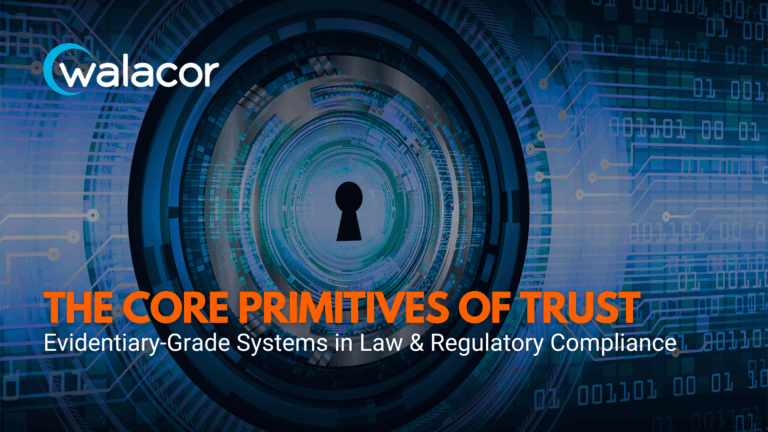
Walacor is a cryptographically verifiable, immutable, and provenance-rich data platform that provides the foundational layer for building evidentiary-grade applications. Rather than serving as a software application, Walacor offers core capabilities that empower developers and system architects to construct powerful forensic-grade systems—analytics engines and compliance pipelines—that demand uncompromising data integrity.
Designed from first principles to support authenticity, auditability, and provability, Walacor makes it possible for any software built on top of it to meet the rigorous expectations of evidentiary trust, whether for enterprise verification, investigative workflows, or compliance monitoring.
Criteria for Evidentiary-Grade Systems
To serve as the backbone for systems that must deliver evidentiary-grade outputs, a data platform must ensure immutability, verifiability, and full lifecycle traceability.
Walacor enforces immutability through its blockchain-enhanced data platform and content-addressed storage, ensuring no data is overwritten and every object is cryptographically hashed. Authenticity is reinforced through digital signatures and cryptographic key based identity bindings for all events and data origins.
Auditability is built into the architecture: every access, transformation, or reference is timestamped and logged. Merkle proofs and deterministic export functions allow reproducibility across time. With this foundation, developers can reconstruct the full lineage of any object—supporting evidence chains that demonstrate exactly how data was created, changed, and consumed providing provable integrity.
Legal and Regulatory Alignment
The capabilities Walacor provides align with global standards for digital evidence systems. Software built on Walacor can be designed to meet:
- U.S. Federal Rules of Evidence through authentication, integrity verification, and self-authenticating digital exports.
- ISO/IEC 27037 for acquisition and preservation of digital evidence.
- NIST SP 800-86 for forensic readiness.
- GDPR and HIPAA for structured data access and retention control.
- SEC, CFTC, and FINRA requirements for financial data traceability.
Walacor provides the foundational capabilities necessary for systems that must align with globally recognized digital evidence standards. By serving as the verifiable core, Walacor allows developers to meet compliance requirements through their own application logic—without needing to engineer integrity mechanisms from scratch.
For example, under the U.S. Federal Rules of Evidence, particularly Rules 901 and 902, digital evidence must be authenticated and self-verifying. Walacor supports this by default through content-addressable storage, cryptographic hashing, and exportable formats that include digital signatures and timestamp metadata. This enables the creation of self-authenticating records that can be verified without relying on live testimony.
Similarly, ISO/IEC 27037 requires reliable acquisition, preservation, and chain-of-custody processes. Walacor’s immutable data structures, signed metadata, and comprehensive audit trails support these needs with forensic rigor. NIST SP 800-86, which promotes forensic readiness, is met through Walacor’s native support for tamper-evident logs and reproducible event histories.
For developers building applications subject to GDPR or HIPAA, Walacor provides structured metadata fields, redaction-compatible provenance tracking, and audit visibility, all necessary for demonstrating responsible handling of personal and sensitive data. Finally, compliance with SEC, CFTC, and FINRA rules regarding financial data integrity is enabled through timestamped records, digital signature enforcement, and verifiable retention.
By building on Walacor, developers inherit these aligned capabilities and can focus their application layers on logic, user experience, and domain-specific compliance workflows, confident that their data integrity stack meets the evidentiary bar.
With Walacor, developers don’t have to spend time building and maintaining their own solutions for:
- Digital signatures
- Timestamping
- Content hashing
- Immutable logging
- Merkle proofs
- Chain-of-custody tracking
Instead, they can rely on Walacor’s capabilities to provide these primitives out of the box. That means they can focus on building business logic, user interfaces, and compliance workflows, not the underlying cryptographic machinery.
Cryptographic Architecture Supporting Evidentiary Trust
At the heart of Walacor is a cryptographic design optimized for verifiability. Objects are stored with hashes, and every collection of events can be proven consistent using Merkle tree inclusion and ordering.
This structure supports lightweight integrity proofs, tamper-evident timestamps, and compatibility with zero-knowledge attestation frameworks. Optional timestamp anchoring to public chains adds an additional layer of visibility and resistance to manipulation.
With these mechanisms in place, applications built on Walacor inherit a model of data storage and access that is inherently provable.
Enabling Application-Layer Export and Verification
Software built atop Walacor can leverage its APIs and export primitives to generate structured evidence packages.
Each object written to Walacor can include:
- Its metadata (origin, timestamp, signatures, lineage)
- A detached digital signature
- A Merkle proof of inclusion and order
- An audit trail showing its full lifecycle
Applications may generate formats such as JSON, CSV, or PDF/A, complete with cryptographic bindings and chain-of-custody logs. These features allow external validators, analysts, or auditors to independently verify the state and history of data, without trusting the application layer.
Specification for Evidence Exports
Developers can use Walacor to build systems that emit structured, verifiable evidence bundles. These bundles may include:
- Primary content object
- Metadata with identity, timestamps, and anchors
- Signature artifacts and hash receipts
- Audit history logs
- Optional Merkle or ZK proofs
Walacor’s export tooling ensures compatibility with human-readable formats and automated machine parsing, while supporting proof structures necessary for independently verifying trust.
Interoperability and Ecosystem Integration
Because Walacor is not an end-user application but a composable secure data infrastructure layer, it is designed to integrate cleanly with existing systems. Evidence bundles can be verified via CLI tools, embedded libraries, or third-party validation platforms.
Structured metadata and logging formats ensure compatibility with SIEM tools, analytics dashboards, and data warehousing systems. Developers can create adapters or microservices that extend Walacor-backed evidence workflows into regulated enterprise stacks, data lakes, or smart contract pipelines.
Built to Power What Comes Next
Walacor was created to provide the foundational substrate for builders who care about verifiability, transparency, and trust. It doesn’t dictate what the end system must be—but ensures that any system built on top of it can prove what it says, how it operates, and where its data came from.
The future of evidentiary-grade software will not be powered by claims alone—it will be anchored in cryptographic proof, traceable data lineage, and tamper-evident design. Walacor is the infrastructure layer where that future begins.


